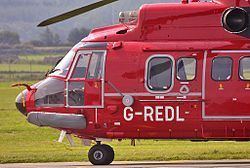Passengers 14 Fatalities 16 Date 1 April 2009 Destination Aberdeen Airport Passenger count 14 | Crew 2 Survivors 0 Number of deaths 16 Survivor 0 | |
 | ||
Summary Main Rotor Gearbox failure Site 11 nmi (20 km) northeast of Peterhead, Scotland Operator Babcock Mission Critical Services Offshore Similar Prudhoe Bay oil spill, Torrey Canyon oil spill, Cougar Helicopters Flight 91, 2013 CHC Helicopters Eurocopt, 2009 Gabonese Eurocopt | ||
The April 2009 North Sea helicopter crash involved a Eurocopter AS332L2 Super Puma Mk 2 belonging to Bond Offshore Helicopters, engaged on flight 85N, that crashed 11 nautical miles (20 km) north-east of Peterhead, Scotland just before 2:00 pm on 1 April 2009 in the North Sea while returning from a BP oil platform in the Miller oilfield, 240 km (150 mi) north-east of Peterhead. The crash killed all sixteen people aboard. The cause was main rotor separation following a catastrophic gearbox failure.
Contents
The helicopter was flown by Captain Paul Burnham and co-pilot Richard Menzies, both working for Bond Offshore Helicopters. Most of the victims were employees of KCA Deutag Drilling.
Bond also operated a very similar Eurocopter EC225LP helicopter which ditched in the North Sea on 18 February 2009, in which all 18 aboard escaped and were rescued.
The most serious previous North Sea helicopter accident had been the 1986 British International Helicopters Chinook crash, when a Boeing 234 Chinook crashed, killing 45 people.
Recovery
The search for survivors was called off on the evening of 2 April, rescuers admitting that there was no chance of finding anyone alive, and the Vigilant returned to Peterhead on 4 April. The eight bodies found a few hours after the crash were taken to Aberdeen and then on to a police mortuary.
The Air Accidents Investigation Branch (AAIB) chartered the seismic survey vessel Vigilant for its initial investigation, which arrived on site on 3 April, carrying specialised sonar equipment to locate the wreckage on the seabed. The aircraft was thought to be lying in approximately 90 metres of water, but as of 3 April the exact location was not known. No EPIRB beacon signal had been reported.
Grampian Police stated on the evening of 4 April that they had identified the eight bodies that were initially recovered from the surface of the sea. One of the victims, Nolan Goble, was the brother of former professional footballer, Steve Goble. A second vessel, the Diving Support Vessel Bibby Topaz, was chartered to assist the work, and sailed from Peterhead on 4 April, to recover the remaining eight bodies that were not found on the surface, as well as wreckage and the cockpit voice and flight data recorders.
The wreckage of the Super Puma was subsequently located on the sea bed in 100 m (330 ft) by the Bibby Topaz. The remaining eight bodies were recovered from inside the fuselage. The combined FDR/CVR was recovered and sent to the Farnborough headquarters of the AAIB for analysis, as was all the wreckage.
Investigation
The AAIB invited the Bureau d'Enquêtes et d'Analyses pour la sécurité de l'Aviation Civile (BEA), Eurocopter, the European Aviation Safety Agency (EASA), and the UK Civil Aviation Authority to participate. The AAIB released a third press statement on 4 April 2009 stating that work to recover the wreckage of G-REDL was continuing.
On 11 April the AAIB released its initial report into the accident in which it stated that the immediate cause of the accident was a "catastrophic failure of the main rotor gearbox" and the consequent detachment of the main rotor. Three safety recommendations were made, the first of which was that all Super Puma helicopters should receive additional checks on the main rotor gearbox epicyclic module.
On 17 April the AAIB released a second report noting that metallic debris from the gearbox had been detected 34 flying hours prior to the helicopter crash. However, "no signs of an incipient gearbox failure were detected". In response, the EASA ordered an "urgent" inspection of the gearboxes on both the AS332L2 Super Puma and the EC225LP Super Puma. Helicopter operators were given to 24 April to complete the inspections.
On 16 July the AAIB published AAIB Special Bulletin: 5/2009 detailing further progress in the investigation, including two further safety recommendations 2009–74 and 2009–75. These respectively called on the EASA to urgently review the manuals on magnetic particle detection and on planetary gear inspection.
On 24 November 2011 the AAIB published its Formal Report 20/2011 into the accident. The cause of the accident was attributed to the catastrophic failure of the Main Rotor Gearbox as a result of a fatigue fracture of a second stage planet gear in the epicyclic module.
In addition the investigation identified three contributory factors:
- The actions taken following the discovery of a magnetic particle on the epicyclic module chip detector on 25 March 2009, 36 flying hours prior to the accident, resulted in the particle not being recognised as an indication of degradation of the second stage planet gear, which subsequently failed.
- After 25 March 2009, the existing detection methods did not provide any further indication of the degradation of the second stage planet gear.
- The ring of magnets installed on the AS332 L2 and EC225 main rotor gearboxes reduced the probability of detecting released debris from the epicyclic module.
Seventeen Safety Recommendations were made as a result of the investigation.
On 13 March 2014, an official UK government inquiry found that the accident could have been prevented if maintenance procedures had been correctly followed.
